Going Out Of This World on Rubber and Laughing Gas
(SpaceShipOne: First Private Launch, 21 June 2004)
by Mia Molvray, photos by Paul J. Kores
(c) 2005
SpaceShipOne’s rocket runs on rubber and laughing gas, and two days later I could still feel the laughing gas. Watching the ship reach for space was a charge that just doesn’t go away.
It didn’t start that way. It started with being turned away from Mojave Airport in the middle of the night while a gale like a tornado in training pounded the car. “The parking lot isn’t set up yet,” said the polite man whose job it was to guard the entrance to the airport. Not “set up”? What did they plan to do? Unroll it from storage in a hangar somewhere? This did not sound promising.
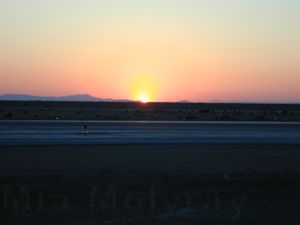 |
| Sunrise at Mojave Airport |
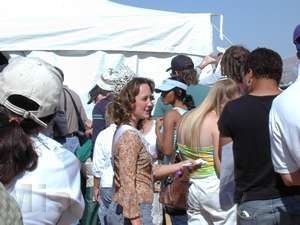 |
| Miss Mojave, in tiara and blue jeans, helps the cause |
We turned around, like the enthusiasts ahead of us, and headed off into the inhospitable night. It was our own fault, unfortunately. The web site said clearly that the lot would open at three a.m. for the 6:30 launch, but my partner, Paul, and I wanted to arrive early. Nothing would be worse than missing the launch because we were stuck in a traffic jam of arriving sightseers. A parking lot, we thought, is a parking lot, and we’d just wait the hours out somewhere, dozing on lawn chairs.
At Mojave Airport, we found out, that’s not the way it works. Unlike most little rural airports, Mojave’s is huge. Part of it is even used as an airplane junk yard for 747s and other big jets, and they just look like small planes in the distance, which shows how enormous the place is. An airport that size, it turned out, has no trouble accommodating thousands of cars. They just wheel generators and flood lights onto the packed dirt and, presto, there’s an instant parking lot. It says a lot for the folks who run the airport that traffic wardens and lights were ready a mere hour later, long before three a.m., and long before the whole town could become a snarl of frustration and lost tempers.
Our notion of dozing in lawn chairs proved ridiculous. Any native could have told us it wouldn’t work. The town of Mojave is not as dry as the desert of the same name, but it is in the desert, so daytime temperatures in June can reach over a hundred and cool off into the fifties after dark, which causes high night time winds. Sand and dust blew off the packed dirt of the airport in clouds, rocking our car and sandblasting the paint. Paul, who’s over six feet tall, couldn’t sleep in our small car no matter what, so he wrapped up in his windbreaker and some towels and braved the elements. I tried to sleep draped across the seats, despite a gear shift and parking brake that were out of sympathy with this project. Supposedly, the winds died down toward morning, which was why the flight was scheduled for 6:30, but it didn’t seem possible that the raging sandstorm could disappear in mere hours. Weeks seemed more likely.
I was surprised to find myself waking up (it had been one of those nights where I knew I hadn’t slept a wink). Early dawn spread a sapphire glow in the east. People had been arriving all night long, and setting up chairs along the fence marking the viewing area. Paul, it turned out, had found prime spots right along the runway, while I and the gear shift had negotiated our uneasy truce. In less time than it took to suck down a morning cup of tea from our thermos, the sky grew flame-colored and the sun floated up from behind one of Mojave’s low mountains. The wind was a gentle breeze ruffling the hair of little kids who’d be going to Mars someday because of what they were seeing here.
The improvised parking lot was now a sea of cars. One van was painted with rockets and stars and said “62 miles up or bust!” SpaceShipOne’s target was 328,000 feet, which is the European definition of the beginning of space. (NASA’s is lower.) The crowd was fifty people deep or more at its thickest along the fence, but sparser where we were. The fence consisted of a yellow nylon rope strung between steel posts set every ten yards or so. Anyone, large or small, could have stepped right through, but nobody did. There was supposed to be a three foot gap between the public and the fence, and airmen from the Civil Air Patrol at nearby Edwards Air Force Base marched up and down trying to get all of us to pay attention to the rules. They had about as much success as you would expect, but they were very nice about it.
Well before 6:30 the excitement started cresting. Rumors would sweep through the crowd that the White Knight had been sighted, that it was on this runway, that it was on that runway, or that it was near the media area a few hundred yards away. The White Knight is a twin-engine jet, also designed by Burt Rutan, and made to carry SpaceShipOne up to launch altitude.
There was supposed to be a link between the control room and a local radio station, but a glitch interfered. The radio station played country music and there was talk of waving a handkerchief out the control tower to give people a heads up at major points. When the White Knight carrying SpaceShipOne underneath it did appear, it was without any fanfare. A few minutes after 6:30 the world’s most elegant and unearthly aircraft rolled easily down the runway.
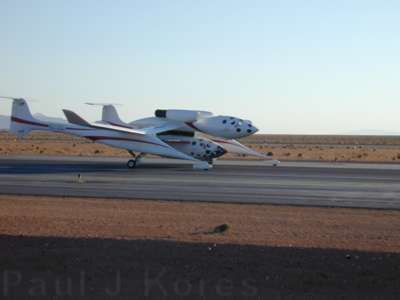
We were cheering our hearts out as it rolled past. Technological achievements can be exciting, awe-inspiring, and life-changing, but they’re not, as a rule, aesthetically pleasing. The White Knight and SpaceShipOne are take-your-breath-away beautiful. The White Knight is not large, as aircraft go, and it looks so light and ready to fly that a strong breeze should be enough to send it swooping skyward.
The mood in the crowd was friendly, excited, tolerant, and polite . . . even toward the one gent (there’s always one) who was on his cell phone giving a loud blow-by-blow account to someone at the other end. “It’s coming down the runway now. It’s rolling past us now. It’s stopping at the end. . . . Yes, it’ll be turning soon for take-off.” I tried to remind myself that the poor person at the other end couldn’t be here, and that it was all in a good cause, but it didn’t help. It was like being at the movies when someone two rows over says, “Ooh, look Darryl, he’s about to kiss her. Ooh, he’s getting closer. Ooh–,” and so on. Kill all cell phones.
Well, the plane did turn, waited a moment, gathered speed for takeoff, and lifted effortlessly into the air. They say the mark of genius is to make difficult work look easy, and Burt Rutan is definitely a genius.
The White Knight – SpaceShipOne pair, followed by two chase planes, flew higher and higher in wide circles over the airport. At over 45,000 feet, SpaceShipOne would drop away and fire its rocket for the flight to space. The process was going to take an hour or so, which meant there was time enough to wait in line at the Porto-Lets. A connection between the control room and the radio station had been established, so word would come through when it was time to scan the skies for the historic event.
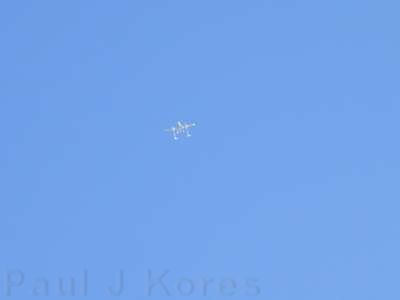
I found out when I came back that it is next to impossible to spot a small white plane that was growing smaller by the second in the vast bowl of bright blue sky. At one point, it passed through an atmospheric layer where it and a chase plane left contrails, so I finally managed to focus them through my binoculars. The problem was that their altitude-gaining circles took them right past the sun, which was well up in the sky by now. Looking at the sun through binoculars is a disaster, so tracking the planes required split-second decisions about whether it was better to lose the aircraft or my eyesight. I chickened out and lost the aircraft. And, in the perverse way of real life, they were no longer leaving contrails. The whole crowd of us was standing around saying, “Can you see them? Can *you* see them?” Nobody could see them, not even one man who’d brought a three-inch telescope to track the event.
Suddenly, not far from the sun, there was a lengthening line of white. SpaceShipOne had fired its rocket. Everyone was yelling and cheering and pointing. There was a brief interruption in the plume of white and a sort of kink in the trajectory, but I had no way of knowing whether that was all part of the plan or not. The plume of white resumed and the leading tip moved faster than anything I’d ever seen. In what felt like no time, but was actually 80 seconds, the rocket burn stopped and we all knew that Mike Melvill was coasting to space, looking at a black, starry sky and a round Earth. We found out later that he was also tossing candy up there and watching it float.
Minutes went by, all of us waiting, looking up, as if what we were trying to see wasn’t invisible. Then came the double sonic boom of SpaceShipOne’s re-entry, like a huge single heartbeat. Moment’s later, someone spotted the tiny dots of aircraft meeting the space ship and following its glide down. Through the binoculars, I could see SpaceShipOne, already in its gliding configuration with its wings flat like an airplane’s rather than up to stabilize its descent. It floated down as effortlessly as it had gone up, following a similar spiral path. Soon it touched down in a perfect landing while a storm of whooping, hollering, whistling, cheering and shouting broke out.
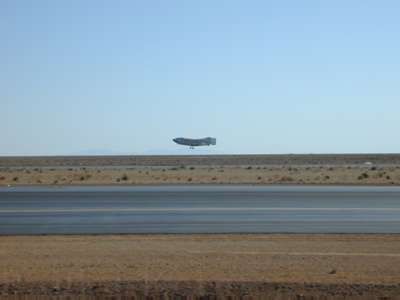
A short while later, the White Knight seemed to be about to land, but instead it revved its jets, climbed steeply, and banked like a fighter in a fully deserved victory lap. Then it landed.
Over the next few hours, details emerged that those of us actually watching the event didn’t know. The kink in the trajectory had been due to a problem with the trim of the wings. Mike had worked around it, but it had taken 30,000 feet from the spacecraft’s altitude. Even so, Edwards AFB reported that the rocket reached the 328,000 foot boundary of space with 491 feet to spare. The trim problem turned out to be minor, and by the time you are reading this the Xprize for the first passenger-carrying, private launches to space has likely been won, and most likely by this very ship.
The last event on the program was a close-up view of SpaceShipOne as it was towed past the cheering crowds. Mike Melvill was standing on top of the ship, waving with as much exuberance as all of us behind the fence. It’s not entirely fair to NASA, since they have lofted a spacecraft or two, but somehow this felt more like the real thing than anything that has gone before. This was *us* doing it, not some bureaucracy with carefully scripted astronauts.
Unexpectedly, the van towing the space ship stopped and Burt Rutan himself got out. He came running across the wide trough of packed dirt up toward the fence. In seconds, he was headed back to the van with a big grin on his face holding a sign one of the viewers had given him. He passed it to Mike and the cheering broke out all over again. The sign said SpaceShipOne: Government Zero.
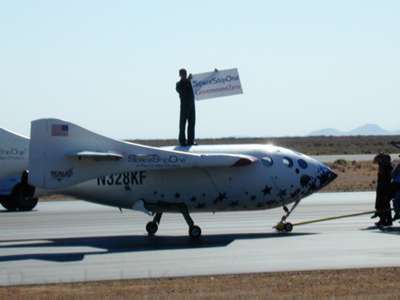
 Print This Post
Print This Post


